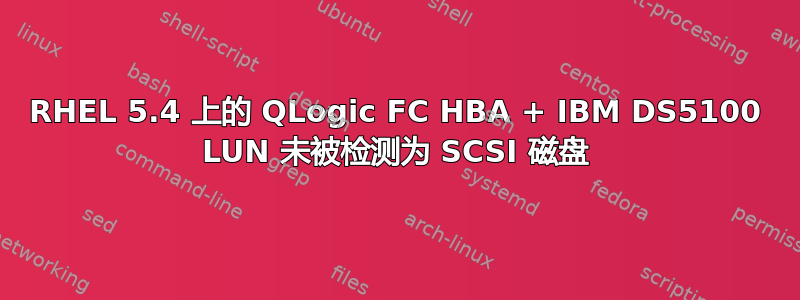
我有一个全新的 DS5100 SAN,它通过两个独立的结构连接到多个主机(BladeCenter H 中的 HS22 Blade)。交换机(BladeCenter 的 Brocade 20p)已正确分区,即 BladeCenter 中的每个主机都可以通过两个结构看到 LUN。RHEL 检测到 BladeCenter 内置 QLogic QMI2572 4G FC CIO 的 qla2xxx 驱动程序,我可以“看到”LUN 被显示为 dmesg 的输出:
qla2xxx 0000:24:00.0: Found an ISP2532, irq 209, iobase 0xffffc20000022000
qla2xxx 0000:24:00.0: Configuring PCI space...
PCI: Setting latency timer of device 0000:24:00.0 to 64
qla2xxx 0000:24:00.0: Configure NVRAM parameters...
qla2xxx 0000:24:00.0: Verifying loaded RISC code...
qla2xxx 0000:24:00.0: Allocated (64 KB) for EFT...
qla2xxx 0000:24:00.0: Allocated (1414 KB) for firmware dump...
scsi4 : qla2xxx
qla2xxx 0000:24:00.0:
QLogic Fibre Channel HBA Driver: 8.03.00.10.05.04-k
QLogic QMI2572 - QLogic 4Gb Fibre Channel Expansion Card (CIOv) for IBM BladeCenter
ISP2532: PCIe (5.0Gb/s x4) @ 0000:24:00.0 hdma+, host#=4, fw=4.04.09 (85)
PCI: Enabling device 0000:24:00.1 (0140 -> 0143)
ACPI: PCI Interrupt 0000:24:00.1[B] -> GSI 42 (level, low) -> IRQ 138
qla2xxx 0000:24:00.1: Found an ISP2532, irq 138, iobase 0xffffc20000024000
qla2xxx 0000:24:00.1: Configuring PCI space...
PCI: Setting latency timer of device 0000:24:00.1 to 64
qla2xxx 0000:24:00.1: Configure NVRAM parameters...
qla2xxx 0000:24:00.1: Verifying loaded RISC code...
qla2xxx 0000:24:00.1: Allocated (64 KB) for EFT...
qla2xxx 0000:24:00.1: Allocated (1414 KB) for firmware dump...
scsi5 : qla2xxx
qla2xxx 0000:24:00.1:
QLogic Fibre Channel HBA Driver: 8.03.00.10.05.04-k
QLogic QMI2572 - QLogic 4Gb Fibre Channel Expansion Card (CIOv) for IBM BladeCenter
ISP2532: PCIe (5.0Gb/s x4) @ 0000:24:00.1 hdma+, host#=5, fw=4.04.09 (85)
qla2xxx 0000:24:00.0: LOOP UP detected (4 Gbps).
qla2xxx 0000:24:00.1: LOOP UP detected (4 Gbps).
Vendor: IBM Model: 1818 FAStT Rev: 0730
Type: Direct-Access ANSI SCSI revision: 05
scsi 4:0:0:0: Attached scsi generic sg1 type 0
Vendor: IBM Model: 1818 FAStT Rev: 0730
Type: Direct-Access ANSI SCSI revision: 05
scsi 4:0:1:0: Attached scsi generic sg2 type 0
Vendor: IBM Model: 1818 FAStT Rev: 0730
Type: Direct-Access ANSI SCSI revision: 05
scsi 5:0:0:0: Attached scsi generic sg3 type 0
Vendor: IBM Model: 1818 FAStT Rev: 0730
Type: Direct-Access ANSI SCSI revision: 05
scsi 5:0:1:0: Attached scsi generic sg4 type 0
现在的问题是它们没有被识别为 SCSI 磁盘,而是通用 SCSI 设备 (/dev/sg{1-4})。“sg_map -i -sd -x”的输出显示:
/dev/sg1 4 0 0 0 0 IBM 1818 FAStT 0730
/dev/sg2 4 0 1 0 0 IBM 1818 FAStT 0730
/dev/sg3 5 0 0 0 0 IBM 1818 FAStT 0730
/dev/sg4 5 0 1 0 0 IBM 1818 FAStT 0730
我的基本理解是,即使这是一个多路径设置,我也不必启用它或实际使用 MPIO。我尝试通过设备映射器多路径快速解决问题,但没有从 multipathd 获得任何输出。``sg_map'' 显示这些设备是磁盘(-sd 标志),但 LUN 未作为 /dev/sd* 连接。我是否必须手动创建正确的设备节点?我是否必须使用 IBM 的 RDAC 或 SDD 驱动程序才能看到它们?
答案1
这很简单;忘记设置 LUN 和节点之间的映射。


